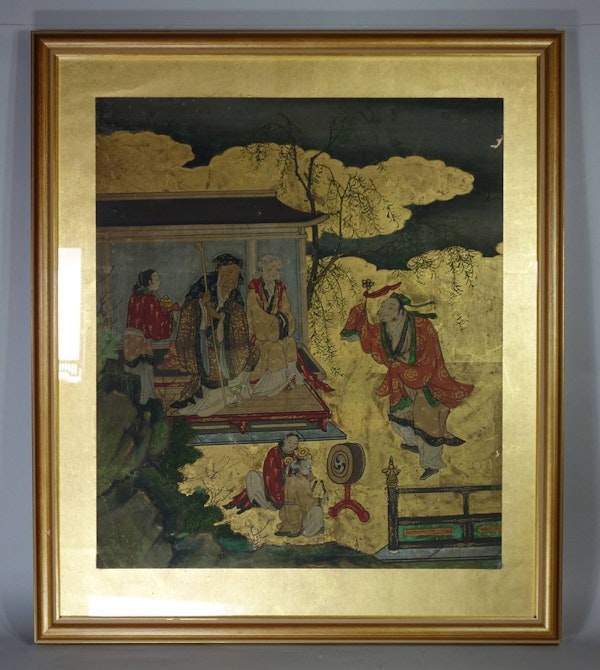Japanese Kano school painting, 17th century
Japanese Kano school painting, 17th century
POA
Description
Japanese Kano school painting, 17th century, in ink against a gold leaf background, depicting Laolaizi, dressed in brightly coloured clothes and jaunty cap, brandishing his rattle gaily with small children accompanying him on the cymbals and drum, before his elderly parents, who are seated upon the veranda of a pavilion looking on in amusement with an attendant serving them, all in a fenced garden with rockwork, painted fence and drifting golden clouds.
Notes: The themes and styles of Chinese art have had a signifiant influence on Japanese painting for hundreds of years, with genres including bird and flower studies, Buddhist religious paintings, inkwash landscapes, and, as seen here, depictions of traditional Confucian tales proving especially popular in medieval and early modern Japan. Despite thematic and stylistic similarities to Chinese models, Japanese paintings display a distinctly Japanese aesthetic. Mirroring this wider narrative of influence and innovation, the Kano school of painters, founded by Kano Masanobu in the 15th century, initially adhered closely to Chinese models, contributing to a revival of Chinese influence within Japanese medieval culture. However, over time the school developed a bolder, more distinctive style with firm outlines and brighter colours, as seen in this example. The Chinese text Quan xiang ershisi xiao shi xuan 全相二十孝詩選 (Selected verses on all aspects of the twenty-four filial exemplars) was compiled in the fourteenth century by the Yuan dynasty Confucian scholar Guo Jujing. The compilation of tales outlining the central Confucian concept of loyalty towards ones parents proved extremely influential across Asia and was translated into Japanese as Nijushiko 二十四孝 in the fifteenth or sixteenth century as well as becoming a popular theme in Japanese art. The tale depicted in this painting is Xi Cai Yu Qin, 戏彩娱亲 (He Dressed Up to Amuse His Parents), which tells the story of a middle-aged hermit who dressed up in flamboyant clothes and behaved in a clownish childlike manner to provide his parents with amusement in their old age.
| item details | |
|---|---|
| Material and Technique | Polychrome inks and gold leaf |
| Origin | Japanese |
| Period | 17th Century |
| Dimensions | Dimensions of frame: 40cm. x 46.4cm. (15 3/4in. x 18 1/4in.) |
Product REF: Q707J


